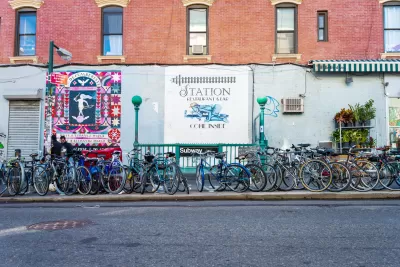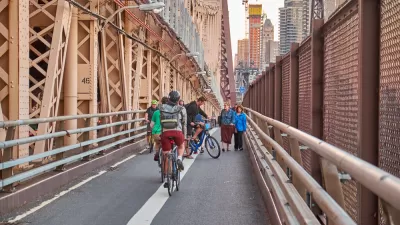Bike rooms for office buildings are hardly new. Now they are making their way into the New York City residential real estate market, big time. These rooms may come with bike repair equipment, and in some cases, the apartments may come with new bikes.

"Driven by demand as well as a city mandate, developers and building owners are carving out bike rooms for residents to store what for some has become their transportation mode of choice," writes Jane Margolies for The New York Times.
The state-of-the-art spaces often have their own entrances, saving wear-and-tear on the lobby and passenger elevators. They also offer their own gear by way of pumps and repair stands, and, sometimes, homey touches like hooks for hanging helmets. In the fancier buildings, porters and door attendants act as bike valets.
Of course, riders can store their bikes in their apartments, if there’s room. But “now when you’re spending a million dollars for a one-bedroom,” said Roberta Axelrod, the director of residential sales and marketing at Time Equities [a real estate agency], “no one wants a bike in there” propped against the wall.
And it's not just new buildings that are seeing the consequences of increased ridership as older buildings are converting underutilized areas into bike rooms. "As for new buildings, a zoning amendment passed in 2009 requires the provision of one bike space for every two units in structures of 10 apartments or more," adds Margolies. However, that's often a bare-bones requirement inadequate for larger units.
If you have a building with two- and three-bedroom apartments, 100 units doesn’t mean 100 bikes,” said Matthew Baron, the president of Simon Baron Development. “It could be 300 or 400.” Consequently, there are waiting lists for many of the city’s bike rooms.
Would you like a bike with that unit?
"Many buildings are providing the bicycles themselves, acquiring their own fleets — emblazoned with the buildings’ names — for residents’ use," writes Margolies. Other buildings are offering bikes as closing gifts. She goes on to list these apartments, in addition to describing bike storage at new and existing apartments in Brooklyn and Manhattan.
Pay-to-Park
But don't expect to park for free; these spaces often come at a cost. "The charges, which can come in the form of a monthly or annual fee, vary widely, from a token $10 per year to $10 to $100 per month," adds Margolies.
FULL STORY: Buildings Get Bike Friendly

Alabama: Trump Terminates Settlements for Black Communities Harmed By Raw Sewage
Trump deemed the landmark civil rights agreement “illegal DEI and environmental justice policy.”

Planetizen Federal Action Tracker
A weekly monitor of how Trump’s orders and actions are impacting planners and planning in America.

The 120 Year Old Tiny Home Villages That Sheltered San Francisco’s Earthquake Refugees
More than a century ago, San Francisco mobilized to house thousands of residents displaced by the 1906 earthquake. Could their strategy offer a model for the present?

Ken Jennings Launches Transit Web Series
The Jeopardy champ wants you to ride public transit.

BLM To Rescind Public Lands Rule
The change will downgrade conservation, once again putting federal land at risk for mining and other extractive uses.

Indy Neighborhood Group Builds Temporary Multi-Use Path
Community members, aided in part by funding from the city, repurposed a vehicle lane to create a protected bike and pedestrian path for the summer season.
Urban Design for Planners 1: Software Tools
This six-course series explores essential urban design concepts using open source software and equips planners with the tools they need to participate fully in the urban design process.
Planning for Universal Design
Learn the tools for implementing Universal Design in planning regulations.
Clanton & Associates, Inc.
Jessamine County Fiscal Court
Institute for Housing and Urban Development Studies (IHS)
City of Grandview
Harvard GSD Executive Education
Toledo-Lucas County Plan Commissions
Salt Lake City
NYU Wagner Graduate School of Public Service




























